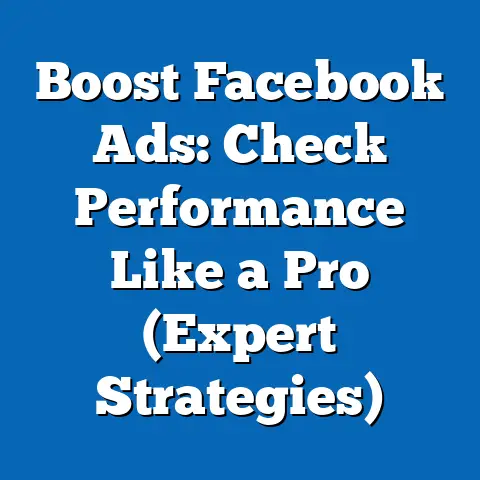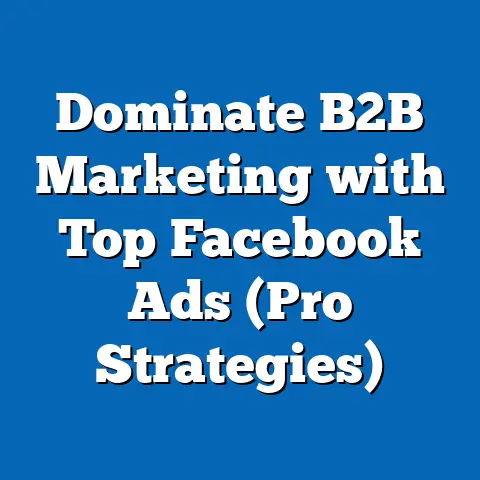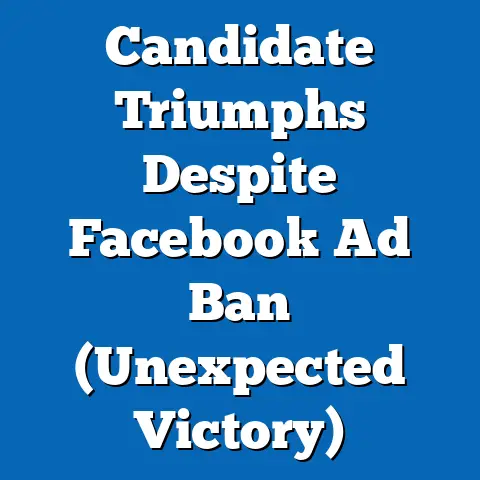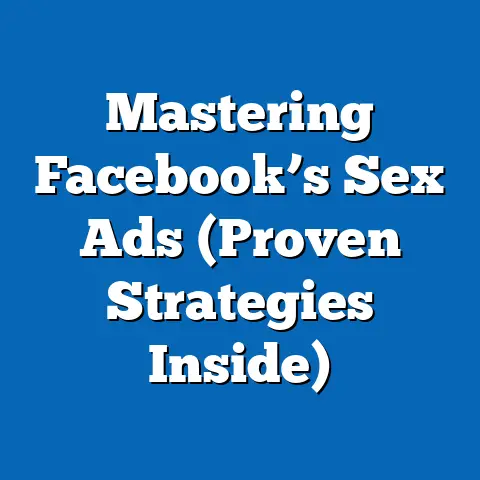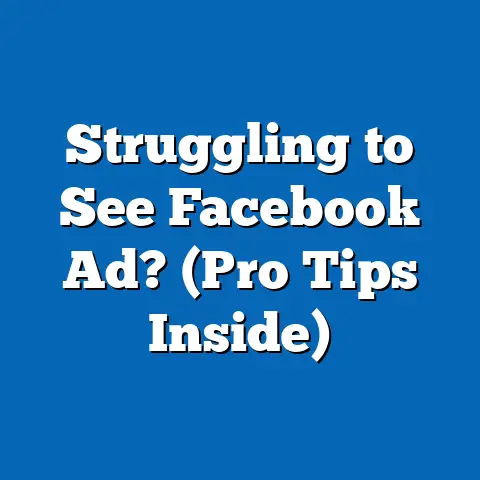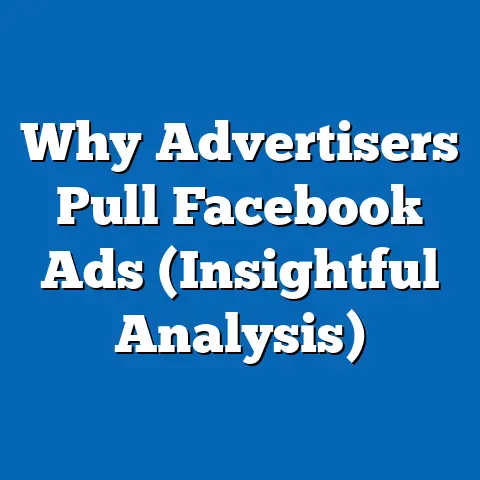Master Facebook Ad Creator Studio (Unlock Powerful Strategies)
Did you know that over 90% of online marketers fail to effectively utilize Facebook Ads, leaving millions in potential revenue on the table? It’s a shocking statistic, and one that I’ve seen play out time and time again in my years as a digital marketing specialist. This failure often stems not from a lack of effort, but from a lack of understanding and effective utilization of the tools available. That’s where Facebook Ad Creator Studio comes in.
I remember when I first started running Facebook Ads, I felt completely overwhelmed. The platform seemed complex and confusing, and I struggled to create campaigns that delivered the results I wanted. It was only when I started diving deep into the features of Facebook Ad Creator Studio that I began to see a real difference in my ad performance.
Facebook Ad Creator Studio is more than just a tool; it’s a gateway to unlocking the true potential of your Facebook advertising efforts. In this article, I’m going to dive deep into its functionalities, providing actionable strategies that will help you leverage its full potential. We’ll move beyond the basics and delve into the nuances that separate successful campaigns from those that simply fade into the noise. Get ready to revolutionize your advertising strategies!
1. Understanding Facebook Ad Creator Studio
Facebook Ad Creator Studio, now integrated within Meta Business Suite, is a comprehensive platform designed to streamline and enhance your ad creation and management process on Facebook and Instagram. It’s a central hub that allows you to plan, create, publish, and analyze your content, all in one place.
Think of it as your mission control for all things Facebook advertising. It provides a unified interface, eliminating the need to jump between different tools and platforms. This not only saves time but also allows for a more cohesive and strategic approach to your marketing efforts.
Why is it so important in the digital marketing landscape?
In today’s fast-paced digital world, efficiency and effectiveness are paramount. Facebook Ad Creator Studio empowers marketers to:
- Centralize Ad Management: Manage ads across Facebook and Instagram from a single dashboard.
- Streamline Content Creation: Easily create and schedule posts, stories, and ads.
- Access In-Depth Analytics: Gain valuable insights into ad performance to optimize campaigns.
- Collaborate Effectively: Facilitate teamwork with content calendars and shared access.
Brief Overview of its Features and Capabilities:
- Content Library: Store and organize your images, videos, and ad copy in one place.
- Scheduling Tools: Plan and schedule your content in advance for optimal timing.
- Ad Creation Tools: Design visually appealing ads with various formats and targeting options.
- Analytics Dashboard: Monitor key metrics such as reach, engagement, and conversions.
- Collaboration Features: Assign roles and permissions to team members for seamless collaboration.
Discuss its Role in Streamlining the Ad Creation and Management Process:
Before Ad Creator Studio, managing Facebook ads often involved a fragmented approach. You might use one tool for creating visuals, another for writing copy, and yet another for scheduling and analyzing performance. This not only wasted time but also increased the risk of errors and inconsistencies.
Ad Creator Studio changes the game by bringing all these functions together in one place. It allows you to:
- Create consistent branding: Ensure your ads align with your overall brand identity.
- Maintain a content calendar: Plan and schedule your content in advance for optimal timing.
- Track performance in real-time: Monitor key metrics and make adjustments as needed.
- Improve collaboration: Streamline communication and teamwork with shared access.
Takeaway: Facebook Ad Creator Studio is your all-in-one solution for managing and optimizing your Facebook advertising efforts. By understanding its features and capabilities, you can streamline your workflow, improve collaboration, and ultimately drive better results.
2. Setting Up Your Ad Account
Before you can start creating and running ads, you need to set up your ad account correctly. This is a crucial step that often gets overlooked, but it can have a significant impact on your ad performance and overall success.
Step-by-Step Guide on Creating an Account and Navigating the Interface:
- Access Meta Business Suite: Go to business.facebook.com and log in with your Facebook account.
- Create a Business Account: If you don’t already have one, click on “Create Account” and follow the prompts to set up your business account.
- Add Your Facebook Page: Link your Facebook Business Page to your business account. If you don’t have a page, create one.
- Navigate to Ad Manager: In Meta Business Suite, click on “All Tools” and select “Ads Manager.”
- Create an Ad Account: If you don’t already have an ad account, you’ll be prompted to create one. Follow the steps to set up your ad account, including selecting your country, time zone, and currency.
- Add Payment Information: Enter your payment information to ensure you can run ads.
Explain the Necessary Settings and Configurations to Optimize for Performance:
- Business Settings: Ensure your business information is accurate and up-to-date.
- Ad Account Roles: Assign appropriate roles and permissions to team members.
- Pixel Setup: Install the Facebook Pixel on your website to track conversions and retarget website visitors.
- Conversion API: Implement the Conversion API to send data directly from your server to Facebook for more accurate tracking.
- Custom Conversions: Define specific actions on your website as conversions to track your desired outcomes.
Highlight the Importance of Linking Your Facebook Business Page and Instagram Account:
Linking your Facebook Business Page and Instagram account is crucial for several reasons:
- Cross-Platform Advertising: Run ads on both Facebook and Instagram from a single campaign.
- Unified Branding: Maintain a consistent brand identity across both platforms.
- Seamless Content Sharing: Easily share content between your Facebook Page and Instagram account.
- Simplified Management: Manage your content and ads from a single dashboard.
I’ve seen businesses struggle because they failed to properly link their accounts. It’s a simple step, but it can make a huge difference in your overall efficiency and effectiveness.
Takeaway: Setting up your ad account correctly is a critical first step in your Facebook advertising journey. By following these steps and configuring your settings properly, you can ensure you’re set up for success from the start.
3. Crafting Compelling Ad Content
In the world of Facebook advertising, content is king. No matter how well you target your audience or optimize your campaigns, if your ad content isn’t compelling, you won’t get the results you want.
Discuss the Significance of Engaging Visuals and Copy in Facebook Ads:
Think about your own experience scrolling through Facebook. What makes you stop and pay attention to an ad? It’s usually a combination of eye-catching visuals and persuasive copy.
- Visuals: High-quality images and videos can grab attention and convey your message quickly and effectively.
- Copy: Well-written ad copy can persuade your audience to take action, whether it’s visiting your website, making a purchase, or signing up for your email list.
Provide Tips on Creating Attention-Grabbing Headlines and Persuasive Ad Copy:
- Keep it concise: Get straight to the point and avoid jargon.
- Highlight benefits: Focus on what your audience will gain from your product or service.
- Use strong verbs: Create a sense of urgency and excitement.
- Ask questions: Engage your audience and encourage them to think.
- Include a clear call to action: Tell your audience exactly what you want them to do.
Explore the Types of Content that Perform Best on Facebook (Images, Videos, Carousels, etc.):
- Images: Use high-quality images that are relevant to your target audience and your offer.
- Videos: Create short, engaging videos that tell a story and capture attention.
- Carousels: Showcase multiple products or features in a single ad.
- Collections: Display a catalog of products in a visually appealing format.
- Instant Experiences: Create immersive, full-screen experiences that load quickly on mobile devices.
I’ve found that video ads tend to perform particularly well on Facebook, especially when they’re optimized for mobile viewing. Short, attention-grabbing videos with clear messaging can be incredibly effective at driving engagement and conversions.
Takeaway: Compelling ad content is essential for success on Facebook. By focusing on creating engaging visuals and persuasive copy, you can capture attention, drive engagement, and achieve your advertising goals.
4. Targeting Your Audience Effectively
One of the greatest strengths of Facebook advertising is its ability to target specific audiences with incredible precision. This allows you to reach the people who are most likely to be interested in your products or services, maximizing your ad spend and improving your ROI.
Explain Facebook’s Advanced Targeting Options, Including Demographics, Interests, and Behaviors:
Facebook offers a wide range of targeting options, including:
- Demographics: Target users based on age, gender, education, location, relationship status, and more.
- Interests: Target users based on their interests, hobbies, and passions.
- Behaviors: Target users based on their online behavior, such as purchase history, device usage, and travel habits.
- Connections: Target users who are connected to your Facebook Page or events.
- Custom Audiences: Target users based on your own data, such as email lists, website visitors, and app users.
- Lookalike Audiences: Target users who are similar to your existing customers or website visitors.
Discuss the Importance of Audience Segmentation and How to Create Custom Audiences:
Audience segmentation involves dividing your target audience into smaller, more specific groups based on shared characteristics. This allows you to tailor your ad content and messaging to each group, increasing the relevance and effectiveness of your ads.
To create custom audiences, you can upload your own data to Facebook or use Facebook’s tracking tools to identify website visitors, app users, and other specific groups.
Introduce Retargeting Strategies to Maximize Ad Effectiveness:
Retargeting involves showing ads to people who have already interacted with your business, such as visiting your website, watching your videos, or engaging with your Facebook Page. This is a highly effective strategy for driving conversions and building brand loyalty.
I’ve seen retargeting campaigns deliver some of the highest ROI of any advertising strategy. By showing ads to people who are already familiar with your brand, you can increase the likelihood of them taking action.
Takeaway: Effective audience targeting is essential for maximizing your ROI on Facebook. By understanding Facebook’s advanced targeting options and implementing audience segmentation and retargeting strategies, you can reach the right people with the right message at the right time.
5. Leveraging Analytics and Insights
Running Facebook ads without tracking and analyzing your results is like driving a car with your eyes closed. You need to know where you’re going and how well you’re progressing towards your destination. That’s where Facebook Ad Insights comes in.
Explain How to Access and Interpret Facebook Ad Insights:
Facebook Ad Insights provides a wealth of data about your ad performance, including:
- Reach: The number of people who saw your ads.
- Impressions: The number of times your ads were displayed.
- Engagement: The number of likes, comments, shares, and clicks your ads received.
- Conversions: The number of desired actions taken as a result of your ads, such as purchases, sign-ups, or form submissions.
- Cost per Result: The average cost of each desired action.
- Click-Through Rate (CTR): The percentage of people who clicked on your ads after seeing them.
- Relevance Score: A measure of how relevant your ads are to your target audience.
To access Ad Insights, go to Ads Manager and select the campaign, ad set, or ad you want to analyze. You’ll see a dashboard with various charts and graphs that provide a visual representation of your ad performance.
Discuss Key Performance Indicators (KPIs) to Monitor for Measuring Ad Success:
The specific KPIs you should monitor will depend on your advertising goals. However, some common KPIs include:
- Cost per Acquisition (CPA): The average cost of acquiring a new customer.
- Return on Ad Spend (ROAS): The amount of revenue generated for every dollar spent on advertising.
- Conversion Rate: The percentage of people who take your desired action after clicking on your ad.
- Click-Through Rate (CTR): The percentage of people who click on your ad after seeing it.
Provide Examples of How to Pivot Strategy Based on Data Analysis:
- Low CTR: If your CTR is low, try improving your ad copy and visuals to make them more appealing.
- High CPA: If your CPA is high, try refining your targeting to reach a more qualified audience.
- Low Conversion Rate: If your conversion rate is low, try optimizing your landing page to make it more user-friendly and persuasive.
I once worked with a client who was struggling to generate leads through their Facebook ads. After analyzing their Ad Insights, I discovered that their ads were getting a lot of clicks, but very few people were actually filling out their lead form. I suggested that they simplify their lead form and make it easier for people to submit their information. As a result, their lead conversion rate increased dramatically, and they were able to generate a significant number of new leads.
Takeaway: Facebook Ad Insights is an invaluable tool for optimizing your advertising efforts. By tracking and analyzing your results, you can identify what’s working and what’s not, and make adjustments to improve your performance.
6. A/B Testing for Optimization
A/B testing, also known as split testing, is a powerful technique for optimizing your Facebook ads. It involves creating two or more versions of an ad and testing them against each other to see which one performs better.
Define What A/B Testing Is and Why It’s Crucial in the Ad Creation Process:
A/B testing allows you to make data-driven decisions about your ad content, targeting, and bidding strategies. By testing different variations of your ads, you can identify the elements that resonate most with your target audience and improve your overall ad performance.
Offer a Guide on How to Set Up A/B Tests Within Creator Studio:
- Create a Campaign: Start by creating a new campaign or selecting an existing one.
- Create an Ad Set: Within your campaign, create a new ad set.
- Duplicate Your Ad Set: Duplicate your ad set to create a second version.
- Make Changes to Your Ad Set: In one of the ad sets, make changes to the element you want to test, such as the ad copy, visuals, or targeting options.
- Run Your A/B Test: Set your budget and schedule and let your A/B test run for a sufficient amount of time to gather statistically significant data.
- Analyze Your Results: After your A/B test is complete, analyze the results to see which version performed better.
Share Case Studies Highlighting Successful A/B Tests and Their Outcomes:
- Headline Testing: A company tested two different headlines for their Facebook ad and found that one headline generated a 30% higher click-through rate.
- Image Testing: A retailer tested two different images for their Facebook ad and found that one image generated a 20% higher conversion rate.
- Call-to-Action Testing: A software company tested two different calls to action for their Facebook ad and found that one call to action generated a 15% higher sign-up rate.
I once ran an A/B test for a client who was promoting a free webinar. We tested two different ad copies, one that focused on the benefits of attending the webinar and another that focused on the pain points that the webinar would address. We found that the ad copy that focused on the pain points generated a significantly higher registration rate.
Takeaway: A/B testing is a crucial part of the ad creation process. By testing different variations of your ads, you can identify the elements that resonate most with your target audience and improve your overall ad performance.
7. Budgeting and Bidding Strategies
Effectively managing your budget and bidding strategies is essential for maximizing your ROI on Facebook. It’s not just about spending money; it’s about spending it wisely.
Discuss the Different Budgeting Options Available (Daily vs. Lifetime Budgets):
Facebook offers two main budgeting options:
- Daily Budget: Set a fixed amount that you’re willing to spend each day on your ads.
- Lifetime Budget: Set a total amount that you’re willing to spend over the entire duration of your campaign.
The best budgeting option for you will depend on your advertising goals and your level of experience. Daily budgets are generally recommended for beginners, as they allow you to control your spending more closely. Lifetime budgets are better suited for experienced advertisers who have a clear understanding of their target audience and conversion rates.
Introduce Various Bidding Strategies and When to Use Them:
Facebook offers several different bidding strategies, including:
- Lowest Cost: Facebook will automatically bid to get you the most results for your budget.
- Cost Cap: You set a maximum cost per result that you’re willing to pay.
- Target Cost: You set a target cost per result that you want to achieve.
- Bid Cap: You set a maximum bid that you’re willing to pay for each impression.
The best bidding strategy for you will depend on your advertising goals and your budget. Lowest Cost is generally recommended for beginners, as it’s the simplest and most automated option. Cost Cap and Target Cost are better suited for experienced advertisers who have a clear understanding of their desired cost per result.
Explain How to Allocate Budget Effectively Across Campaigns:
Allocating your budget effectively across campaigns is crucial for maximizing your ROI. Here are some tips:
- Prioritize High-Performing Campaigns: Allocate more budget to campaigns that are delivering the best results.
- Test New Campaigns with Smaller Budgets: Test new campaigns with smaller budgets to see how they perform before allocating a larger budget.
- Monitor Performance Regularly: Monitor your campaign performance regularly and make adjustments as needed.
I’ve found that it’s often helpful to start with a smaller budget and gradually increase it as you see positive results. This allows you to test different strategies and optimize your campaigns without risking a large amount of money.
Takeaway: Effective budgeting and bidding strategies are essential for maximizing your ROI on Facebook. By understanding the different budgeting options and bidding strategies available, you can allocate your budget effectively and achieve your advertising goals.
8. Scaling Successful Campaigns
Once you’ve identified a successful Facebook ad campaign, the next step is to scale it up to reach a larger audience and generate even more results. However, scaling a campaign can be tricky, and it’s important to do it carefully to avoid diminishing returns.
Provide Strategies for Identifying Successful Campaigns and Scaling Them:
- Identify High-Performing Campaigns: Use Facebook Ad Insights to identify campaigns that are delivering the best results, based on your chosen KPIs.
- Increase Your Budget: Gradually increase your budget for high-performing campaigns to reach a larger audience.
- Expand Your Targeting: Expand your targeting to reach new audiences who are similar to your existing customers.
- Create Lookalike Audiences: Use Facebook’s Lookalike Audiences feature to target users who share similar characteristics to your best customers.
- Duplicate Successful Ads: Duplicate successful ads and use them in new campaigns to reach a wider audience.
Discuss the Importance of Maintaining Ad Quality While Increasing Spend:
As you increase your budget, it’s important to maintain the quality of your ads. This means ensuring that your ads are still relevant, engaging, and persuasive.
- Monitor Ad Performance: Monitor your ad performance closely to see if your results are declining as you increase your budget.
- Refresh Your Ad Creative: Refresh your ad creative regularly to keep your ads fresh and engaging.
- Test New Ad Variations: Test new ad variations to see if you can improve your results.
Share Tips on How to Use Lookalike Audiences for Broader Reach:
Lookalike Audiences are a powerful tool for expanding your reach and targeting new audiences who are similar to your existing customers. To create a Lookalike Audience, you need to provide Facebook with a source audience, such as a list of your best customers or a list of people who have visited your website. Facebook will then use this data to identify users who share similar characteristics.
I’ve found that Lookalike Audiences can be incredibly effective at driving conversions and acquiring new customers. By targeting users who are similar to your best customers, you can increase the likelihood of them being interested in your products or services.
Takeaway: Scaling successful campaigns is a key part of maximizing your ROI on Facebook. By following these strategies and maintaining ad quality, you can reach a larger audience and generate even more results.
9. Common Mistakes to Avoid
Even experienced Facebook advertisers make mistakes from time to time. However, by being aware of these common pitfalls, you can avoid them and improve your overall ad performance.
Highlight Frequent Pitfalls Marketers Encounter When Using Facebook Ad Creator Studio:
- Poor Targeting: Targeting too broad of an audience or targeting the wrong audience.
- Weak Ad Creative: Using low-quality images or videos, or writing unpersuasive ad copy.
- Ignoring Ad Insights: Failing to track and analyze your ad performance.
- Not A/B Testing: Not testing different variations of your ads to see which ones perform better.
- Setting the Wrong Budget: Setting a budget that’s too low or too high.
- Not Monitoring Ad Performance: Failing to monitor your ad performance regularly and make adjustments as needed.
Discuss the Importance of Compliance with Facebook’s Advertising Policies:
Facebook has strict advertising policies that you need to comply with. If you violate these policies, your ads may be disapproved, your ad account may be suspended, or your Facebook Page may be banned.
- Review Facebook’s Advertising Policies: Familiarize yourself with Facebook’s advertising policies before creating your ads.
- Avoid Prohibited Content: Avoid including prohibited content in your ads, such as hate speech, discriminatory content, or misleading claims.
- Disclose Information: Disclose all necessary information in your ads, such as disclaimers, terms and conditions, and privacy policies.
Offer Solutions to Mitigate These Mistakes and Enhance Ad Performance:
- Refine Your Targeting: Use Facebook’s advanced targeting options to reach a more qualified audience.
- Improve Your Ad Creative: Invest in high-quality images and videos, and write persuasive ad copy.
- Track and Analyze Your Ad Performance: Use Facebook Ad Insights to track and analyze your ad performance.
- A/B Test Your Ads: Test different variations of your ads to see which ones perform better.
- Set a Realistic Budget: Set a budget that’s appropriate for your advertising goals.
- Monitor Your Ad Performance Regularly: Monitor your ad performance regularly and make adjustments as needed.
I’ve seen businesses get their ad accounts suspended because they didn’t comply with Facebook’s advertising policies. It’s important to take these policies seriously and ensure that your ads are compliant.
Takeaway: By being aware of these common mistakes and following these solutions, you can avoid them and improve your overall ad performance on Facebook.
10. Future Trends in Facebook Advertising
The world of Facebook advertising is constantly evolving, and it’s important to stay up-to-date on the latest trends and technologies. This will help you stay ahead of the competition and maximize your ROI.
Explore Emerging Trends and Technologies That May Impact Facebook Advertising:
- Artificial Intelligence (AI): AI is being used to automate various aspects of Facebook advertising, such as ad creation, targeting, and bidding.
- Augmented Reality (AR): AR is being used to create immersive ad experiences that allow users to interact with products and services in a new way.
- Virtual Reality (VR): VR is being used to create even more immersive ad experiences that transport users to virtual worlds.
- Personalization: Personalization is becoming increasingly important in Facebook advertising, with advertisers using data to create more relevant and engaging ads.
- Video Advertising: Video advertising continues to grow in popularity, with more and more advertisers using video to capture attention and tell stories.
Discuss the Role of AI and Machine Learning in Optimizing Ad Performance:
AI and machine learning are playing an increasingly important role in optimizing ad performance on Facebook. These technologies can be used to:
- Automate Ad Creation: AI can be used to generate ad copy, select images, and create videos.
- Improve Targeting: AI can be used to identify the most qualified audience for your ads.
- Optimize Bidding: AI can be used to automatically adjust your bids to get you the best results for your budget.
- Personalize Ads: AI can be used to personalize ads based on user data.
Speculate on the Future of Digital Marketing on Social Platforms:
The future of digital marketing on social platforms is likely to be driven by several factors, including:
- Increased Personalization: Ads will become even more personalized, with advertisers using data to create highly relevant and engaging experiences.
- More Immersive Experiences: AR and VR will be used to create more immersive ad experiences that transport users to virtual worlds.
- Greater Automation: AI and machine learning will be used to automate more aspects of the advertising process.
- Increased Focus on Privacy: Social platforms will need to balance the need for personalization with the need to protect user privacy.
I believe that AI will play a huge role in the future of Facebook advertising. It will help advertisers create more effective ads, target the right audiences, and optimize their campaigns for maximum ROI.
Takeaway: By staying up-to-date on the latest trends and technologies in Facebook advertising, you can stay ahead of the competition and maximize your ROI.
Conclusion
Mastering Facebook Ad Creator Studio is no longer optional; it’s an absolute necessity for any marketer looking to achieve real, measurable results in today’s competitive digital landscape. As I’ve shown you throughout this guide, this powerful tool provides a wealth of features and capabilities that can streamline your workflow, improve collaboration, and ultimately drive better outcomes.
From setting up your ad account correctly to crafting compelling ad content, targeting your audience effectively, leveraging analytics and insights, A/B testing for optimization, budgeting and bidding strategies, scaling successful campaigns, avoiding common mistakes, and staying up-to-date on future trends, the strategies I’ve discussed are essential for unlocking the full potential of your Facebook advertising efforts.
Remember, success on Facebook doesn’t happen overnight. It requires a commitment to learning, experimenting, and constantly optimizing your campaigns. But with the right tools and strategies, you can achieve your advertising goals and drive significant growth for your business.
Call to Action
Now it’s your turn. Don’t let this knowledge sit idle. Start implementing these strategies today. Dive into Facebook Ad Creator Studio, explore its features, and experiment with different approaches to see what works best for your business.
And remember, the world of Facebook advertising is constantly evolving, so it’s important to stay curious, keep learning, and continually adapt your strategies to stay ahead of the competition. The potential is there; it’s up to you to unlock it.

